B0041VYHGW EBOK (149 page)
Authors: David Bordwell,Kristin Thompson

The experimental filmmaker may tell no story, creating poetic reveries such as Willard Maas’s
Geography of the Body
(
10.46
)
or pulsating visual collages such as
Ballet mécanique,
which serves as one of our main examples here. Alternatively, the filmmaker may create a fictional story, but it usually challenges the viewer. Yvonne Rainer’s
Film About a Woman Who …
presents its narrative partly through a series of slides that a group of men and women are watching. At the same time, on the sound track, we hear anonymous voices carrying on a dialogue, but we cannot confidently assign any voice to a particular character. Rainer thus forces us to weigh everything we see and hear on its own terms, apart from any involvement with characters
(
10.47
).
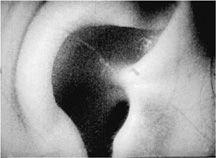
10.46 In
Geography of the Body,
an ear creates an abstract, lyrical composition.
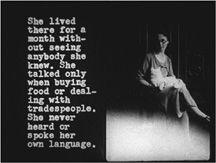
10.47 Thanks to Rainer’s combination of images, sounds, and captions in
Film About a Woman Who …,
the viewer is left free to imagine several possible stories.
“One of the things that goes on in
Critical Mass
(this is also true of much of the rest of my work and of the work by others I admire) is a process of training the spectator to watch the film.”— Hollis Frampton, experimental filmmaker
Any sort of footage may be used for an avant-garde film. Images that a documentarist might take as fragments of actuality can be mobilized for quite different purposes
(
10.48
).
Bruce Conner pulls footage from travelogues and newsreels to create a sweeping image of the destruction of civilization in
A Movie
(
pp. 376
–381). Within the experimental mode, such scavenged works are often called
found-footage films.
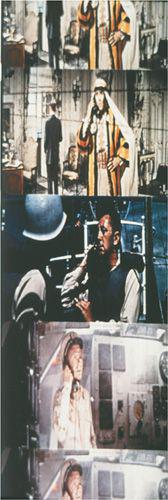
10.48 Gianfranco Baruchello’s
La Verifica inserta
scavenges frames from old features to create a flicker film, here juxtaposing shots including telephones.
Experimentalists have also used staging to express distinct feelings or ideas
(
10.49
).
By superimposing different portions of a kitchen scene from a fiction film, Ivan Galeta’s
Two Times in One Space
creates cycles of people splitting or drifting like phantoms. There is avant-garde animation as well, as in Breer’s
Fuji
(
pp. 388
–390) and Red Grooms’s
Tappy Toes
(
10.50
).
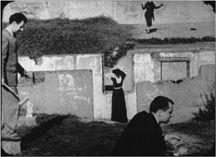
10.49 James Broughton’s
Mother’s Day
offers static pictures of adults playing children’s games.
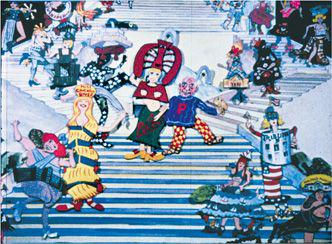
10.50 Pop-art painter Red Grooms animates cut-out figures to create the cheerful experimental film
Tappy Toes.
The freedom available to experimental film is on flamboyant display in Kenneth Anger’s
Scorpio Rising.
Anger takes as his subject the motorcycle culture of the 1960s, and he includes scenes of bikers working on their machines, dressing, reveling, and racing. Alongside footage of bikers glimpsed on the streets or in parties, there are many staged incidents—chiefly around Scorpio, a James Dean–like figure. Anger also cuts in still photos, comic strips, old movies, and Nazi posters. In addition, each segment is accompanied by a rock-and-roll song that adds an ironic or ominous tone to the images. For example, as one young man fetishistically tunes up his bike, Anger shows the figure of death looming over him
(
10.51
),
and on the sound track we hear, “My boyfriend’s back … and he’s coming after you.” This sequence links biking to a death wish, an idea that returns in cartoons and other imagery. In such ways,
Scorpio Rising
creates elusive but powerful associations, suggesting the homoerotic dimensions of bike culture, comparing its rituals to fascism and Christianity, and evoking the possibility that people often model their behavior on images supplied by mass media.
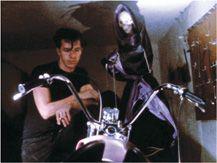
10.51 Death imagery in
Scorpio Rising.
Impossible to define in a capsule formula, avant-garde cinema is recognizable by its efforts at self-expression or experimentation outside mainstream cinema. Yet the boundary lines can be breached. Techniques associated with the avant-garde have been deployed in music videos by Michel Gondry and Chris Cunningham. In fact, Conner, Anger, Derek Jarman, and other experimentalists were early pioneers of music video. And mainstream features have been continually drawing on the avant-garde for ideas and techniques. Over the history of film, the basic modes have cross-fertilized each other constantly.
Like documentaries, experimental films sometimes use narrative form. James Sibley Watson, Jr., and Melville Webber’s 1928 film
The Fall of the House of Usher
evokes the atmosphere of the Edgar Allan Poe story through expressionistic sets and lighting. Occasionally, we find an experimental film organized by categories, as in Peter Greenaway’s
The Falls,
a mockumentary tracing, in alphabetical order, information about a disparate group of people named Fall. Still other types of form are characteristic of experimental films: abstract form and associational form.
CONNECT TO THE BLOG
We have written on some recent experimental films in “Lewis Klahr X 3, X 4,” at
www.davidbordwell.net/blog/?p=157
;
“3 notions about CREMASTER 2,” at
www.davidbordwell.net/blog/?p=418
;
“Manhattan: Symphony of a great city,” at
www.davidbordwell.net/blog/?p=1709
;
and “Lines of sight and light,” at
www.davidbordwell.net/blog/?p=2198
.
When we watch a film that tells a story, or surveys categories, or makes an argument, we usually pay little attention to the sheer pictorial qualities of the shots. Yet it’s possible to organize an entire film around colors, shapes, sizes, and movements in the images.
How? Consider
Railroad Turnbridge,
by the sculptor Richard Serra. A turn-bridge allows a section of railroad tracks to swivel on a central column, clearing space for tall boats passing along the river. Serra set up a camera at the center of a turnbridge and filmed the bridge’s movement. The result onscreen is surprising. The bridge is swiveling, but because the camera is anchored to it, the crossed girders and powerful uprights seem monumentally static, and the landscape rotates majestically
(
10.52
).
There is no argument, no survey of categories. A narrative film might have used the bridge for an exciting chase or fight, but Serra invites us to contemplate the bridge as a geometrical sculpture, all grids and angles, in relation to the curves and sweeps of nature beyond. Serra asks us to notice and enjoy the slowly changing pictorial qualities of line, shape, tonalities, and movement.
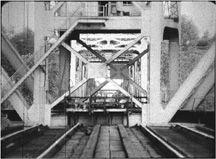
10.52 The slowly changing background obliges the viewer to notice the symmetrical geometry of the bridge’s design in
Railroad Turnbridge.